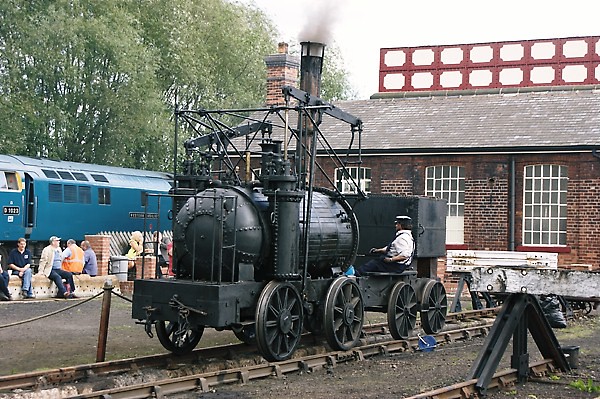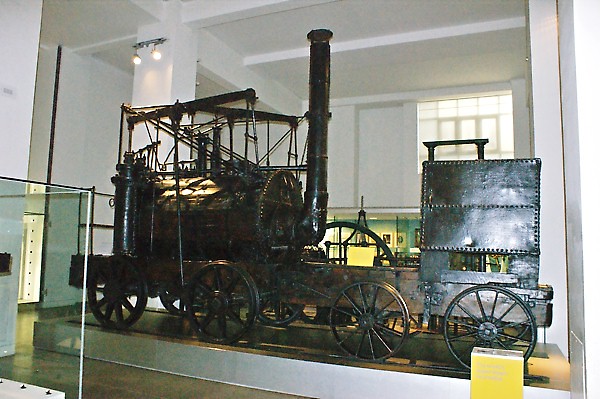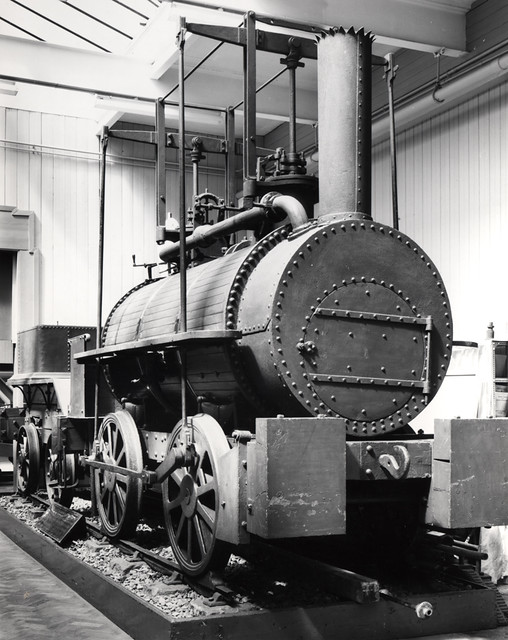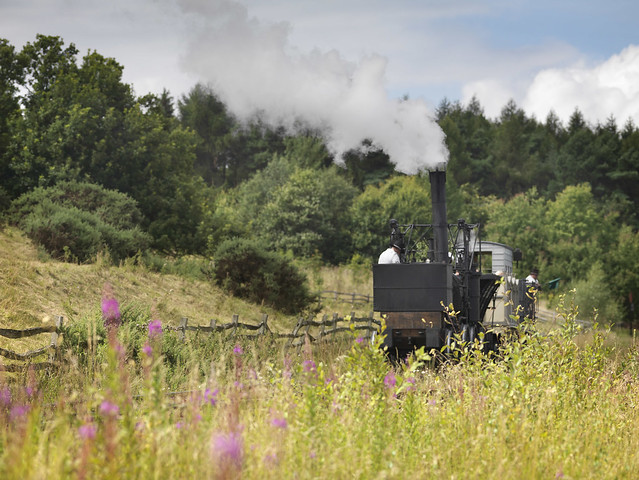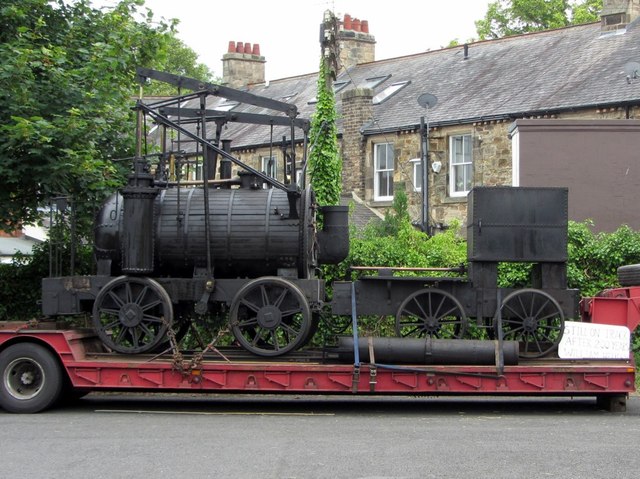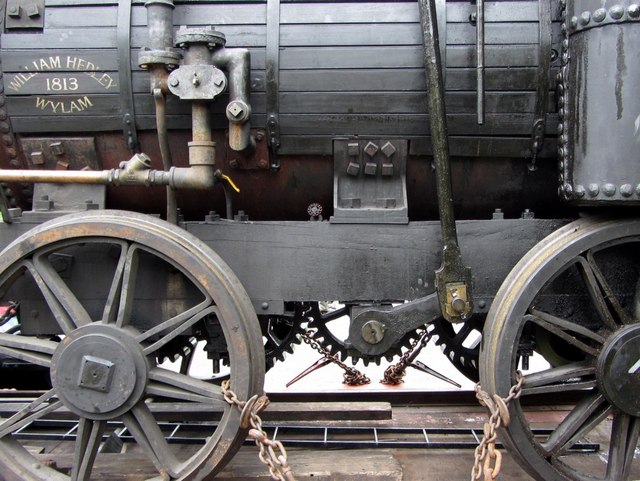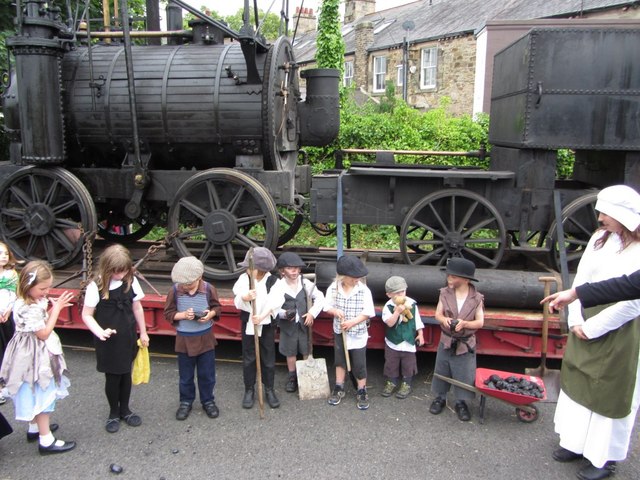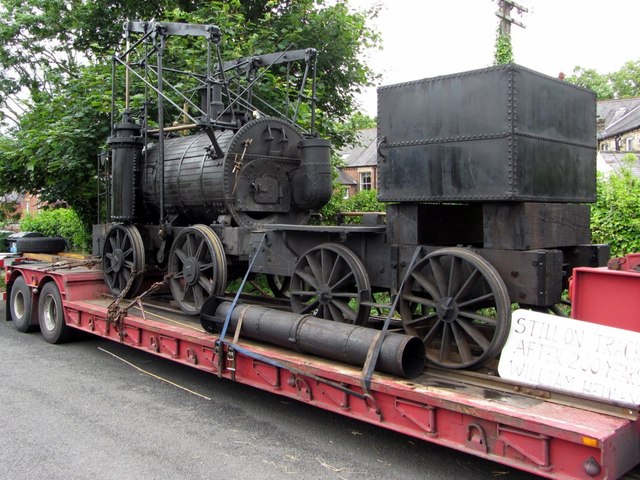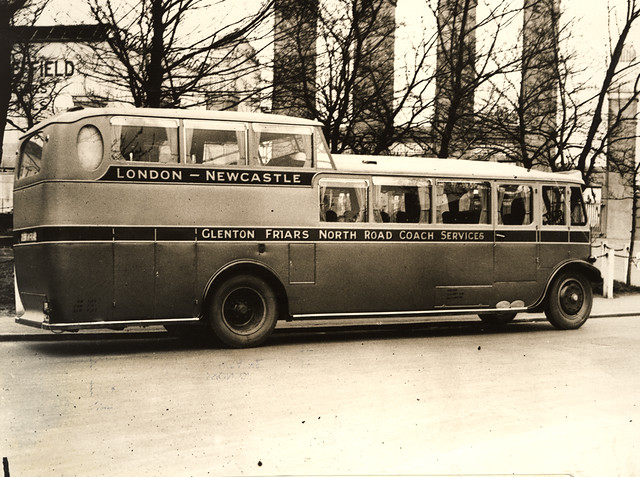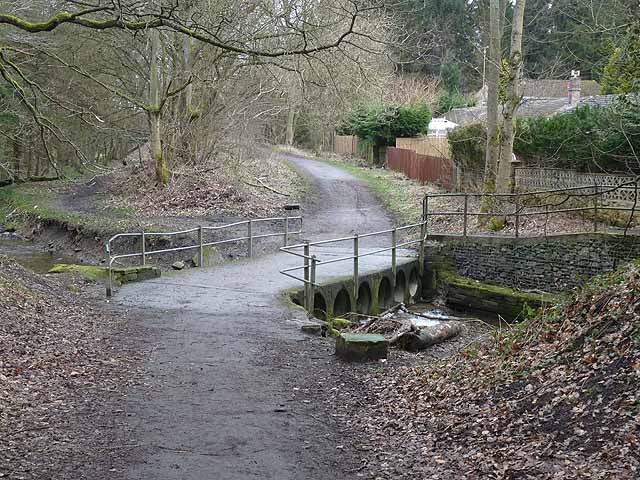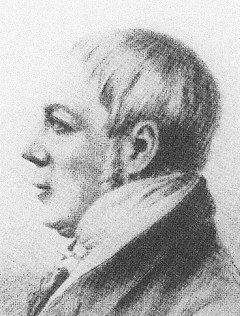Topics > Transport and Travel > Railway > Locomotives > Puffing Billy
Puffing Billy
Puffing Billy, built 1813, is the oldest surviving steam locomotive. It was built by William Hedley (engineer), Jonathan Forster (engine wright) and Timothy Hackworth (blacksmith) for Wylam Colliery, to haul coal wagons to the docks at Lemington on the River Tyne. Puffing Billy had an important influence on George Stephenson and its success promoted the use of steam locomotives by other collieries in the North East. Puffing Billy is exhibited in London Science Museum, and there is a working replica at Beamish. Wylam Dilly is its sister locomotive, build around the same time. (Grace's Guide: British Industrial History)
Puffing Billy is an early railway steam locomotive, constructed in 1813–14 by engineer William Hedley, enginewright Jonathan Forster and blacksmith Timothy Hackworth for Christopher Blackett, the owner of Wylam Colliery near Newcastle upon Tyne, in the United Kingdom. It is the world's oldest surviving steam locomotive. It was the first commercial adhesion steam locomotive, employed to haul coal chaldron wagons from the mine at Wylam to the docks at Lemington-on-Tyne in Northumberland.
History
Puffing Billy was one of the three similar engines built by Hedley, the resident engineer at Wylam Colliery, to replace the horses used as motive power on the tramway. In 1813 Hedley built for Blackett's colliery business on the Wylam Colliery line the prototypes, "Puffing Billy" and "Wylam Dilly". They were both rebuilt in 1815 with ten wheels, but were returned to their original condition in 1830 when the railway was relaid with stronger rails.
In the September 1814 edition of Annals of Philosophy two locomotives with rack wheels are mentioned (probably Salamanca and Blücher), then there is mention of "another steam locomotive at Newcastle, employed for a similar purpose coals, and moving along without any rack wheel, simply by its friction against the rail road". From the context this is at a different location to Blücher, so is probably Puffing Billy.
Puffing Billy remained in service until 1862, Edward Blackett, the owner of Wylam Colliery, lent it to the Patent Office Museum in South Kensington, London (later the Science Museum). He later sold it to the museum for £200. It is still on display there. Its sister locomotive, Wylam Dilly, is preserved in the Royal Museum in Edinburgh.
A replica has been built and was first run in 2006 at Beamish Museum. Another replica, built 1906 in a Royal Bavarian State Railways workshop, can be found in the German Museum, Munich.
Design
Puffing Billy incorporated a number of novel features, patented by Hedley, which were to prove important to the development of locomotives. It had two vertical cylinders on either side of the boiler, and partly enclosed by it, and drove a single crankshaft beneath the frames, from which gears drove and also coupled the wheels allowing better traction.
The engine had a number of serious technical limitations. Running on cast iron Wagonway plates, its eight-ton weight was too heavy and broke them, encouraging opponents of locomotive traction to criticise the innovation. This problem was alleviated by redesigning the engine with four axles so that the weight was spread more evenly. The engine was eventually rebuilt as a four-wheeler when improved edge rails track was introduced around 1830. It was not particularly fast, being capable of no more than 5 mph (8 km/h).
Legacy
Puffing Billy was an important influence on George Stephenson, who lived locally, and its success was a key factor in promoting the use of steam locomotives by other collieries in north-eastern England.
It also entered the language as a metaphor for an energetic traveller, and phrases like "puffing like Billy-o" and "running like Billy-o" are thought to derive from the locomotive's name.
Visit the page: Puffing Billy (locomotive) for references and further details. You can contribute to this article on Wikipedia.
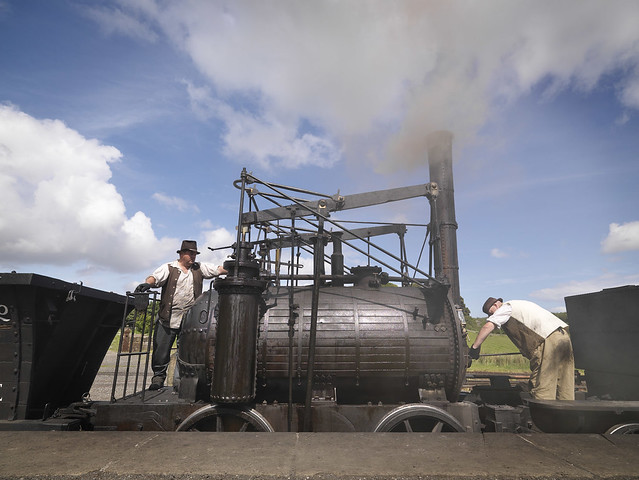
from Beamish (flickr)
Puffing Billy at The 1825 Beamish Pockerley Waggonway
Pinned by Simon Cotterill
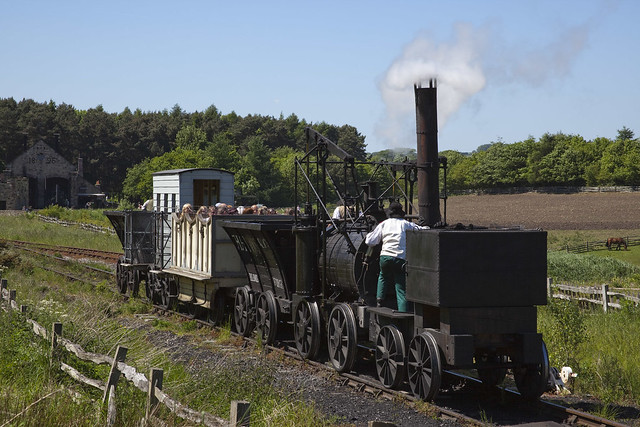
from Beamish (flickr)
Puffing Billy at Pockerley Waggonway, Beamish Museum
Pinned by Simon Cotterill
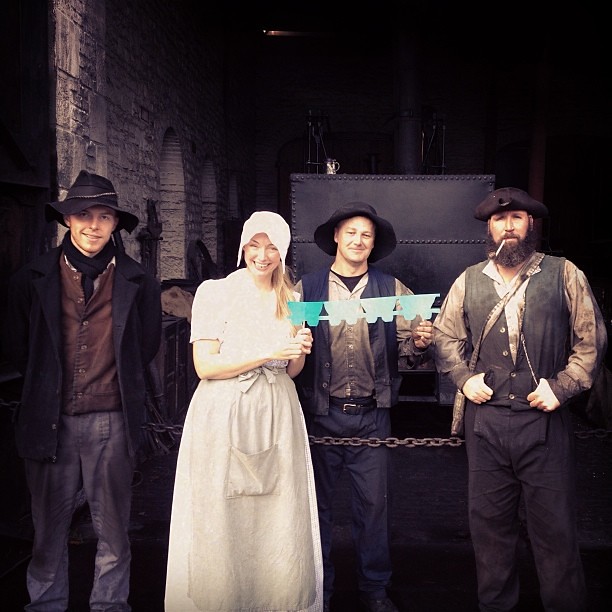
from Beamish (flickr)
Puffing Billy celebrations about to begin at Pockerley Waggonway!
Pinned by Simon Cotterill

from Beamish Museum (youtube)
Beamish Museum: Pockerley Waggonway and Old Hall
Pinned by Simon Cotterill
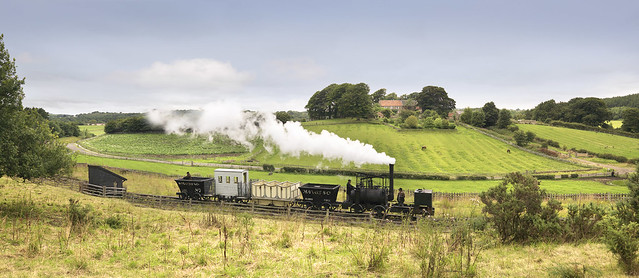
from Beamish (flickr)
Puffing Billy steams through the Georgian Landscape at Beamish
Pinned by Simon Cotterill
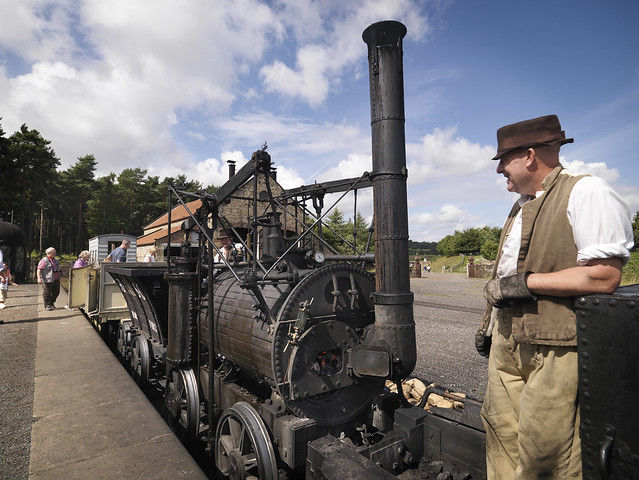
from Beamish (flickr)
Puffing Billy at The 1825 Beamish Pockerley Waggonway
Pinned by Simon Cotterill

from http://heddonhistory.weebly.c…
Lemington Staiths and Lemington Gut
- "As part of my research for the Puffing Billy Festival this summer I decided to see what I could find out about the eastern end of the Wylam Waggonway. This …
Added by
Simon Cotterill
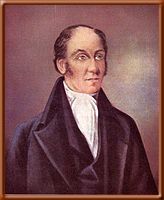
from http://commons.wikimedia.org/…
Painting of Timothy Hackworth
- Public domain image c/o Wikimedia Commons.
Added by
Simon Cotterill

Co-Curate Page
Timothy Hackworth (1786-1850)
- Summary About Timothy Hackworth Timothy Hackworth was an engineer and inventor, born in Wylam on the 22nd December 1786. He began work as an apprentice blacksmith under his father at …

Co-Curate Page
1813
- < 1812 | 1813 | 1814 > In Northern England: 1813; Puffing Billy built for Wylam Colliery, the oldest surviving steam locomotive. 1813; founding of the Society of Antiquaries of Newcastle upon …

Co-Curate Page
Wylam Colliery
- "John Blackett (1712-1779) established coal mining and Wylam Colliery in the township in the mid 18th century. The waggonway connecting the colliey to the River Tyne at Lemington was built …


from Beamish (flickr)
Puffing Billy at The 1825 Beamish Pockerley Waggonway
Pinned by Simon Cotterill

from Beamish (flickr)
Puffing Billy at Pockerley Waggonway, Beamish Museum
Pinned by Simon Cotterill

from Beamish (flickr)
Puffing Billy celebrations about to begin at Pockerley Waggonway!
Pinned by Simon Cotterill

from Beamish Museum (youtube)
Beamish Museum: Pockerley Waggonway and Old Hall
Pinned by Simon Cotterill

from Beamish (flickr)
Puffing Billy steams through the Georgian Landscape at Beamish
Pinned by Simon Cotterill

from Beamish (flickr)
Puffing Billy at The 1825 Beamish Pockerley Waggonway
Pinned by Simon Cotterill

from http://heddonhistory.weebly.c…
Lemington Staiths and Lemington Gut
- "As part of my research for the Puffing Billy Festival this summer I decided to see what I could find out about the eastern end of the Wylam Waggonway. This …
Added by
Simon Cotterill

from http://commons.wikimedia.org/…
Painting of Timothy Hackworth
- Public domain image c/o Wikimedia Commons.
Added by
Simon Cotterill

Co-Curate Page
Timothy Hackworth (1786-1850)
- Summary About Timothy Hackworth Timothy Hackworth was an engineer and inventor, born in Wylam on the 22nd December 1786. He began work as an apprentice blacksmith under his father at …

Co-Curate Page
1813
- < 1812 | 1813 | 1814 > In Northern England: 1813; Puffing Billy built for Wylam Colliery, the oldest surviving steam locomotive. 1813; founding of the Society of Antiquaries of Newcastle upon …


